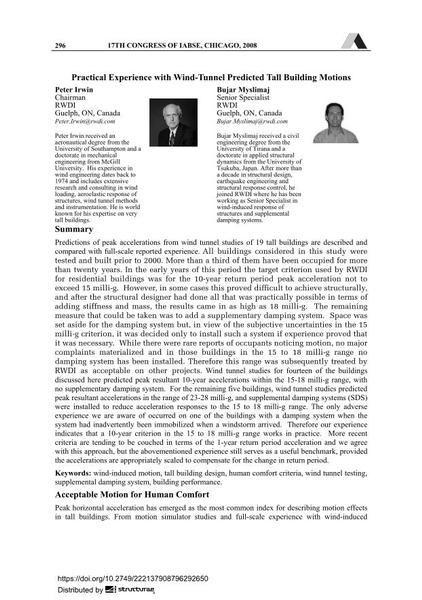Practical Experience with Wind-Tunnel Predicted Tall Building Motions

|
|
|||||||||||
Détails bibliographiques
| Auteur(s): |
Peter Irwin
Bujar Myslimaj |
||||
|---|---|---|---|---|---|
| Médium: | papier de conférence | ||||
| Langue(s): | anglais | ||||
| Conférence: | 17th IABSE Congress: Creating and Renewing Urban Structures – Tall Buildings, Bridges and Infrastructure, Chicago, USA, 17-19 September 2008 | ||||
| Publié dans: | IABSE Congress Chicago 2008 | ||||
|
|||||
| Page(s): | 296-297 | ||||
| Nombre total de pages (du PDF): | 9 | ||||
| Année: | 2008 | ||||
| DOI: | 10.2749/222137908796292650 | ||||
| Abstrait: |
Predictions of peak accelerations from wind tunnel studies of 19 tall buildings are described and compared with full-scale reported experience. All buildings considered in this study were tested and built prior to 2000. More than a third of them have been occupied for more than twenty years. In the early years of this period the target criterion used by RWDI for residential buildings was for the 10-year return period peak acceleration not to exceed 15 milli-g. However, in some cases this proved difficult to achieve structurally, and after the structural designer had done all that was practically possible in terms of adding stiffness and mass, the results came in as high as 18 milli-g. The remaining measure that could be taken was to add a supplementary damping system. Space was set aside for the damping system but, in view of the subjective uncertainties in the 15 milli-g criterion, it was decided only to install such a system if experience proved that it was necessary. While there were rare reports of occupants noticing motion, no major complaints materialized and in those buildings in the 15 to 18 milli-g range no damping system has been installed. Therefore this range was subsequently treated by RWDI as acceptable on other projects. Wind tunnel studies for fourteen of the buildings discussed here predicted peak resultant 10-year accelerations within the 15-18 milli-g range, with no supplementary damping system. For the remaining five buildings, wind tunnel studies predicted peak resultant accelerations in the range of 23-28 milli-g, and supplemental damping systems (SDS) were installed to reduce acceleration responses to the 15 to 18 milli-g range. The only adverse experience we are aware of occurred on one of the buildings with a damping system when the system had inadvertently been immobilized when a windstorm arrived. Therefore our experience indicates that a 10-year criterion in the 15 to 18 milli-g range works in practice. More recent criteria are tending to be couched in terms of the 1-year return period acceleration and we agree with this approach, but the abovementioned experience still serves as a useful benchmark, provided the accelerations are appropriately scaled to compensate for the change in return period. |
||||
